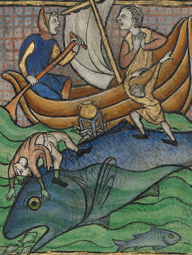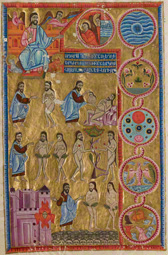|
Long before the invention of photography and motion pictures, artists strove to tell stories visually. This was particularly true in the Middle Ages, when artists often took inspiration from written narratives. In illuminated manuscripts, texts and images are closely interwoven, appearing in many creative combinations.
The manuscripts in this exhibition feature some of the ingenious methods that medieval illuminators used to depict crucial factors of narrative: the drama of decisive
moments, the development of events through time, and verbal interaction.
Although various visual techniques help convey what is happening, viewers still need to interpret certain clues and complete the tales in their imagination. In this way, fixed images on the page come alive.
|
 |

 |
 |
Initial H: Judith Beheading Holofernes (detail), in Scholastic History, Austria, about 1300
|
 |
 |
|
|
 |
One of the most common ways that medieval artists illustrated stories was with single images inserted at intervals throughout the text. But these individual narrative scenes were more than simple snapshots. The moments chosen for depiction were strategically selected, and visual hints were often included to help the viewer imagine what happened before and after. Sometimes, artists combined several stages of an event into one image, thus constructing an artificial moment.
In the scene that fills this initial H, the biblical heroine Judith saves her city from a siege led by the Assyrian general Holofernes by seducing, then beheading him. The dramatic moment of his death is captured by the artist's choice to focus on the second and fatal strike of the sword.
|
 |
|
|
 |

 |
 |
Scenes from the Story of Two Witnesses (detail), in Dyson Perrins Apocalypse, probably London, about 1255–60
|
 |
 |
|
|
 |
In medieval manuscripts, the depiction of a sequence of events can occur either within a single image or as a series of separately framed scenes. Although a series can give more narrative information, the viewer still has to jump from scene to scene and fill in the gaps between them. Often, the artist helps identify the protagonists involved in successive events—for instance, by using the same costume for each character throughout.
In Scenes from the Story of the Two Witnesses, this use of recurring characters happens in two locations on each page: in the illumination and in the margins. In these scenes, which form part of a larger picture cycle, two preachers are approached by a devilish beast. Saint John, whose account of the end of the world forms the basis of this book's text, peers through a window as witness to the events.
|
 |
|
Stories move forward not only through physical action but also through dialogue and other forms of verbal action. In the current age of cartoons and comics, one is accustomed to seeing speech balloons incorporated into pictorial narratives. Medieval illuminators integrated script into their images as well, but they also found other ways to depict what is being said. Techniques included using significant gestures or showing the subsequent effects of spoken words.
In The Creation of the World, for example, the Armenian artist collapsed a series of events into a single page, told very effectively through repeated images of the key figures—God, Adam, and Eve—and their hand gestures, which convey conversation.
|
 |
|
Narrative picture cycles in manuscripts functioned like medieval dramas performed in church, inviting the viewer to imaginatively enter biblical history. The painted stories that played out across the pages were often unaccompanied by text. Readers had to bring their own knowledge of the Bible to the illuminations, which served to activate memory and devotion.
Created in the twelfth century, the Museum's Life of Christ was designed to tell the story of Christ's childhood, ministry, and Passion entirely through pictures. Three centuries later the manuscript was transformed into a personal prayer took with the addition of text and new images.
|
 |
|
|
 |




